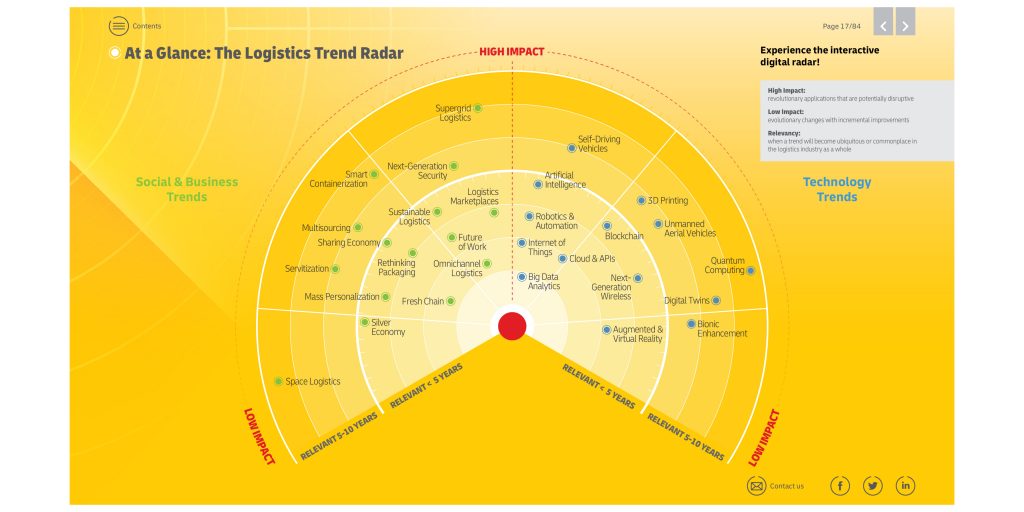DHL has released its latest Logistics Trends Radar report, highlighting the direction of travel for the industry and the latest emerging trends, both in terms of business practice and technology.
As the report’s foreword notes, “The defining business trend of recent years has been the emergence of a new generation of giant technology platforms which can count their users in the billions. US players such as Amazon, Apple, Facebook, Google and Microsoft, as well as China’s Alibaba, Baidu and Tencent, have become central to the lives of many citizens. Their offerings, based largely on free access, social connectivity and almost limitless volumes of informative and entertaining content, have dramatically changed the way people use and appreciate technology. For many, the services of these organizations have become an indispensable part of their lives. These attitudes towards technology also carry over from personal life into business, setting the expectations of executives and IT decision makers in business-to-business activity.”
According to DHL, there are a number of factors driving trends within the logistics industry. The report notes that trends are inherently kinetic, with endlessly shifting positions and momentums, as larger macroforces – like demographics, government policies and customer demand – combine and shape the industry landscape.
Over the last two years, DHL’s Innovation Centers have witnessed and tracked numerous exciting advances, as well as unexpected setbacks, within the trends across the Logistics Trend Radar, and the DHL Trend Research Team has adjusted the position of each trend to reflect the average weight of new developments.
A number of trends have been omitted from the latest report, either due to no longer being relevant, or they have been superseded by others covering a similar area. For example, Tube Logistics has been dropped from the radar. “Tube Logistics was recognized as a trend resting on the outer edges that could yield new, alternative modes of transport for packages and freight. Like most trends before it, this trend is on a steep part of the hype curve but remains there,” DHL noted.
“The potential viability of the technologies and the impact that Tube Logistics will have on the industry are limited without a life-size operating proof-of-concept. Tube Logistics is therefore considered to be outside the 10-year scope of this Logistics Trend Radar. However, it is not without precedent that an excluded trend can develop, mature and find its way back into a future edition.”
Similarly, new trends have made an appearance, such as multi-sourcing and next generation security. In the latter’s case, the report explained, “Security and privacy are values already at the heart of the logistics industry, but recent technology (although generally beneficial) has been misused to target, exploit and disrupt supply chains around the world. To combat these 21st century threats and further close older gaps, the trend of Next-Generation Security involves a new wave of security products and services. These are smarter and more resilient than the dangers and risks they are required to subdue. No other logistics trend on the previous Logistics Trend Radar properly reflected the upcoming generation of best practices in cybersecurity and intelligent physical security. This is why Next-Generation Security is featured as a new trend in this edition.”
Overall, DHL’s latest report provides a thorough rundown of the technologies and best practices logistics companies should be considering as they plan both short and long term.
The full report can be downloaded here.


